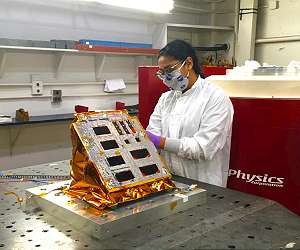A new method for constructing special solar cells could significantly increase their efficiency. Not only are the cells made up of thin layers, they also consist of specifically arranged nanoblocks. This has been shown in a new study by an international research team led by the Martin Luther University Halle-Wittenberg (MLU), which was published in the scientific journal Nano Letters.
Commercially available solar cells are mostly made of silicon. “Based on the properties of silicon it’s not feasible to say that their efficiency can be increased indefinitely,” says Dr Akash Bhatnagar, a physicist from the Centre for Innovation Competence (ZIK) “SiLi-nano” at MLU. His research team is therefore studying the so-called anomalous photovoltaic effect which occurs in certain materials.
The anomalous photovoltaic effect does not require a p-n junction which otherwise enables the flow of current in silicon solar cells. The direction of the current is determined at the atomic level by the asymmetric crystal structure of the corresponding materials. These materials are usually oxides, which have some crucial advantages: they are easier to manufacture and significantly more durable.
However, they often do not absorb much sunlight and have a very high electrical resistance. “In order to utilise these materials and their effect, creative cell architectures are needed that reinforce the advantages and compensate for the disadvantages,” explains Lutz Muhlenbein, lead author of the study.
In their new study, the physicists introduced a novel cell architecture, a so-called nanocomposite. They were supported by teams from the Bergakademie Freiberg, the Leibniz Institute of Surface Modification in Leipzig and Banaras Hindu University in India. In their experiment, the researchers stacked single layers of a typical material only a few nanometres in thickness on top of one another and offset them with nickel oxide strips running perpendicularly.
“The strips act as a fast lane for the electrons that are generated when sunlight is converted into electricity and which are meant to reach the electrode in the solar cell,” Bhatnagar explains. This is precisely the transport that would otherwise be impeded by the electrons having to traverse each individual horizontal layer.
The new architecture actually increased the cell’s electrical output by a factor of five. Another advantage of the new method is that it is very easy to implement. “The material forms this desired structure on its own. No extreme external conditions are needed to force it into this state,” says Muhlenbein.
The idea, for which the researchers have now provided an initial feasibility study, could also be applied to materials other than nickel oxide. Follow-up studies now need to examine if and how such solar cells can be produced on an industrial scale.
Research Report: “Nanocomposites with Three-Dimensional Architecture and Impact on Photovoltaic Effect”
Related Links
Martin-Luther-University Halle-Wittenberg
All About Solar Energy at SolarDaily.com
|
We need your help. The SpaceDaily news network continues to grow but revenues have never been harder to maintain. With the rise of Ad Blockers, and Facebook – our traditional revenue sources via quality network advertising continues to decline. And unlike so many other news sites, we don’t have a paywall – with those annoying usernames and passwords. Our news coverage takes time and effort to publish 365 days a year. If you find our news sites informative and useful then please consider becoming a regular supporter or for now make a one off contribution. |
||
|
SpaceDaily Contributor $5 Billed Once credit card or paypal |
SpaceDaily Monthly Supporter $5 Billed Monthly paypal only |
|

![]()
Lunar solar experiment build completed despite challenges
Cleveland OH (SPX) Jan 28, 2021
NASA is one step closer to understanding the solar power challenges and opportunities on the Moon’s surface after completing the build and readiness review of the Photovoltaic Investigation on the Lunar Surface, or PILS, experiment. The agency overcame multiple engineering challenges to get the experiment ready for integration with a commercial lander for a ride to the Moon as part of NASA’s Commercial Lunar Payload Services (CLPS) initiative.
“NASA’s last opportunity to use solar power on the sur … read more
